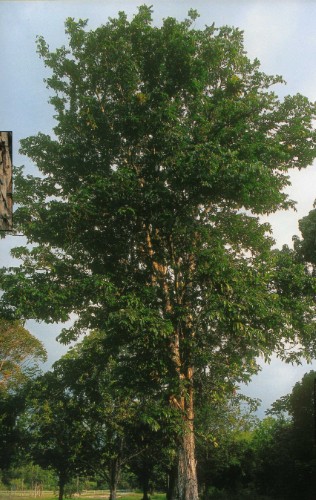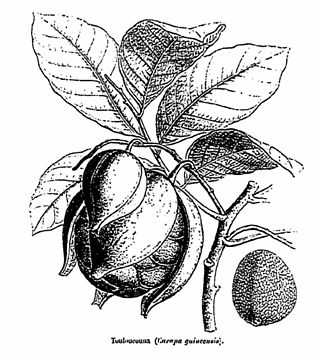
Meliaceae, the mahogany family, is a flowering plant family of mostly trees and shrubs in the order Sapindales.

Herring are various species of forage fish, mostly belonging to the family of Clupeidae.

Carapa is a genus of flowering plants in the mahogany family, Meliaceae. These are trees up to 30 meters tall occurring in tropical South America, Central America, and Africa. Common names include andiroba and crabwood.

Calophyllum brasiliense (guanandi) is a species of plant in the family Calophyllaceae. It is native to subtropical and tropical regions of Mexico, Central America, South America and the Caribbean.

Kemp's gerbil is a species of rodent. Mammal Species of the World considers G. kempi and G. gambianus to be synonyms, however the IUCN has assessed each taxon as were they different species.
Anisoptera megistocarpa is a species of plant in the family Dipterocarpaceae. It is found in Indonesia, Malaysia, and Singapore.
Iryanthera is a flowering plant genus in the family Myristicaceae.
Iryanthera megistocarpa is a species of plant in the family Myristicaceae. It is endemic to Panama. It is threatened by habitat loss.
Refugio Carapá is a biological reserve in the Department of Canindeyú, Paraguay, on the right bank of the Paraná River. It is one of eight sites earmarked as an ecological reserve near the Itaipu Dam, one of the largest dams in the world, located between Paraguay and Brazil. The reserve is 260 km (160 mi) north of the Ciudad del Este. It was founded in 1984 and is 3,250 hectares.

Baboons are primates comprising the genus Papio, one of the 23 genera of Old World monkeys, in the family Cercopithecidae. There are six species of baboon: the hamadryas baboon, the Guinea baboon, the olive baboon, the yellow baboon, the Kinda baboon and the chacma baboon. Each species is native to one of six areas of Africa and the hamadryas baboon is also native to part of the Arabian Peninsula. Baboons are among the largest non-hominoid primates and have existed for at least two million years.

The World's 25 Most Endangered Primates is a list of highly endangered primate species selected and published by the International Union for Conservation of Nature (IUCN) Species Survival Commission (SSC) Primate Specialist Group (PSG), the International Primatological Society (IPS), Global Wildlife Conservation (GWC), and Bristol Zoological Society (BZS). The IUCN/SSC PSG worked with Conservation International (CI) to start the list in 2000, but in 2002, during the 19th Congress of the International Primatological Society, primatologists reviewed and debated the list, resulting in the 2002–2004 revision and the endorsement of the IPS. The publication was a joint project between the three conservation organizations until the 2012–2014 list when BZS was added as a publisher. The 2018–2020 list was the first time Conservation International was not among the publishers, replaced instead by GWC. The list has been revised every two years following the biannual Congress of the IPS. Starting with the 2004–2006 report, the title changed to "Primates in Peril: The World's 25 Most Endangered Primates". That same year, the list began to provide information about each species, including their conservation status and the threats they face in the wild. The species text is written in collaboration with experts from the field, with 60 people contributing to the 2006–2008 report and 85 people contributing to the 2008–2010 report. The 2004–2006 and 2006–2008 reports were published in the IUCN/SSC PSG journal Primate Conservation,, since then they have been published as independent publications.

Hypocala subsatura is a species of moth in the family Erebidae. It is found from the Oriental region to Sundaland.

Lecythis ampla is a species of woody plant in the family Lecythidaceae, which also includes the Brazil nut. Common names include coco, olla de mono, jicaro and salero. It is found in Central and South America. It has been considered an endangered species in Costa Rica.

Carapa guianensis is a species of tree in the family Meliaceae, also known by the common names andiroba or crabwood.
The Jamanxim National Park is a national park in the state of Pará, Brazil.

Carapa procera, called African crabwood, is a species of tree in the genus Carapa, native to the West African tropics and to the Amazon rainforest, and introduced to Vietnam. Some authorities have split off the South American population into its own species, Carapa surinamensis. The nuts are intensively collected in the wild for their oil, a non-timber forest product. In tropical Africa, the species is increasingly threatened.










